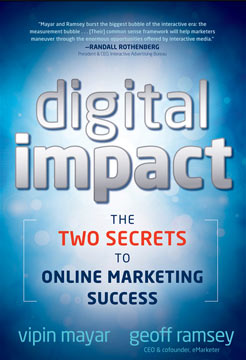 In Digital Impact: The two Secrets to Online Marketing Success (Wiley), co-authors Geoff Ramsey, CEO and co-founder of eMarketer, and Vipin
Mayar, global leader for marketing performance at McCann Worldwide, cough up the goods early in the game. And while the first secret -- good metrics -- isn’t much of a secret these days,
the pair have plenty of well-organized, easy-to-follow specifics on how to get your arms around the metrics that matter most (such as qualified visits and engagement). And they deliver just as well on
their second secret, which is creating “magnetic” content. Yes, it should be unique, useful and well done, they say. But it also needs to be fun, and perfectly suited to the channel
it’s using. (Two examples are ING’s ATM Hunter app, and Domino’s Pizza Delivery Tracker.)
In Digital Impact: The two Secrets to Online Marketing Success (Wiley), co-authors Geoff Ramsey, CEO and co-founder of eMarketer, and Vipin
Mayar, global leader for marketing performance at McCann Worldwide, cough up the goods early in the game. And while the first secret -- good metrics -- isn’t much of a secret these days,
the pair have plenty of well-organized, easy-to-follow specifics on how to get your arms around the metrics that matter most (such as qualified visits and engagement). And they deliver just as well on
their second secret, which is creating “magnetic” content. Yes, it should be unique, useful and well done, they say. But it also needs to be fun, and perfectly suited to the channel
it’s using. (Two examples are ING’s ATM Hunter app, and Domino’s Pizza Delivery Tracker.)
advertisement
advertisement
Their advice is broken down into chapters for social, mobile, and email, as well as
how to build a better dashboard, and include brief case histories from companies like Batteries.com and Publishers Clearinghouse.
Additional digital insights come from Chatter Marketing:
Putting the relationship back in customer relationship management, by Neil Rosen (Emerald Book Co.), who focuses on how keeping tabs on the "chatter" produced by consumers, such as questions on
Twitter, searches on Web sites, products "liked" on Facebook, and posts in user groups, can give marketers a deeper look into the minds of their customers.
Digital customer retention has
become increasingly difficult, he says, because your brand is in the hands of so many more retailers, from Rue La La and Groupon to eBay and Craigslist. Those companies have their own way of nurturing
customer relationships. The remedy is chatter marketing, which he defines as the polar opposite of spam. It uses social media to track “opted in” consumers online, and then market to them
accordingly. (It’s an arrangement that involves plenty of trust -- not so easy to gain in these days of privacy concerns. Customers have to believe the companies they give their
addresses to will not sell, rent or spam.)
In fact, Rosen’s so convinced that chatter is the future that he’s got the chutzpah to predict the demise of Google and other search
engines. Not only do users have to type in keywords, he says, but the pages they get back are too noisy. And while they bring customers to your products, SEO engines also bring them right to your
competition. We’re not holding our breath on that particular prophesy, but the book is an informative and easy read.
Prefer some hard work to easy reading? Then roll up your sleeves and
buy The Successful Marketing Plan: How to create dynamic, results-oriented marketing; by Roman G. Hiebing, Jr.; Scott W. Cooper; and Steven J. Wehrenberg, (McGraw-Hill), now in its fourth
edition. While some of the copious do’s and don’ts are a little flat-footed, at more than 550 pages, the large softcover is exhaustive: There are some 475 marketing situations with 11
columns of “idea starters.” And that’s just in the last chapter.